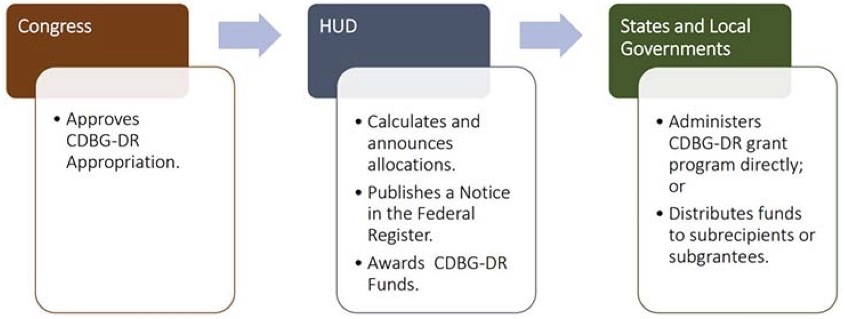- Billions of taxpayer dollars are expended on hurricane recovery in North Carolina
- Disaster responses historically fail to meet victims’ needs and waste significant funds
- The federal government should step back and assume its proper role, giving more responsibility to states and freeing up bottlenecks in the current system
Disaster recovery funding in the United States is multifaceted and complex. In North Carolina, hurricane disaster funding is no different. Funding comes from both federal and state levels, in addition to for-profit and nonprofit aid. Due to the number of agencies involved, disaster recoveries are often not handled in an efficient manner, dealing real harm to the most vulnerable.
Unfortunately, disaster declarations are so frequent that families suffer. States are incentivized to declare disasters, allowing the state to collect more federal aid while draining less from state reserves. Inefficient response times and poor agency coordination cause significant bottlenecks. Disaster spending, though profuse, it not distributed in a timely manner, nor is it properly monitored or logged. Limited tax dollars too often go to waste.
Federal funding
Federal recovery funding streams from three primary agencies: the Federal Emergency Management Agency (FEMA), the U.S. Small Business Administration (SBA), and the U.S. Department of Housing and Urban Development (HUD).
In recent years, FEMA sent nearly $400 million to the state of North Carolina for recovery from Hurricane Matthew (2016) and nearly $1 billion for Hurricane Florence (2018). SBA offered loans to homeowners, renters, and small businesses during the disasters. HUD also provides disaster relief to states, cities, and counties.
Since its creation in 2018 after Hurricane Florence, the North Carolina Office of Recovery and Resiliency (NCORR), also called Rebuild NC, administers the federal funds from HUD. NCORR is housed within the North Carolina Department of Public Safety. Before 2018, the North Carolina Department of Commerce was the grantee for HUD funds.
Altogether NCORR manages $788 million in federal recovery funds from HUD for Hurricanes Matthew and Florence.
NCORR primarily administers Community Development Block Grant Disaster Recovery (CDBG-DR) funds, which are “last resort” funds for those with the most need during presidentially declared disasters. Unlike FEMA and SBA funds, the HUD assistance through CDBG-DR is not “permanently authorized,” and the program will sunset when the funds run out. HUD works with FEMA and SBA to “determine the eligible grantees, geographical areas to be served or prioritized, and allocation amounts.”
Flowchart of Community Development Block Grant Disaster Recovery (CDBG-DR) funds

Source: The HUD Exchange
State funding
The state’s response to hurricanes has generally been through legislative action. For example, in response to Hurricane Matthew, the North Carolina General Assembly allocated more than $300 million to recovery efforts.
For Hurricane Florence, the General Assembly established the Hurricane Florence Disaster Recovery Fund. This same legislation created NCORR within DPS. The two pieces of legislation, S.L. 2018-136 and S.L. 2018-134, transferred nearly $850 million in state tax dollars to the Recovery Fund for Hurricane Florence. The majority of this funding was pulled from the Savings Reserve, or Rainy Day Fund. Since then, additional funding has brought the total spending to $942 million.
“I did not think the process would take this long”: Program delays and waste leave victims behind
Disaster recovery programs have historically been the subject of intense scrutiny and audits.
The General Assembly’s own Program Evaluation Division said the Hurricane Matthew response was wrought with missteps, leading to delays and wasteful spending, even though just 1% of the CDBG-DR funding was spent as of December 2018.
A September 2022 report conducted by HUD said the state “could not provide reasonable assurance to HUD that more than $2.5 million of the $5.4 million in CDBR-DR funds reviewed was spent properly” in response to helping families affected by Hurricane Matthew. Much of the issue lies in “pushing through the bottleneck in the contracting process” according to reporting from The News & Observer.
An April 2022 report from the State Auditor’s office found $500 million of Hurricane Florence recovery funds under the Department of Public Safety were distributed with limited monitoring, and $780 million was distributed without ensuring recipients had a method to measure results.
On July 18 Senate leader Phil Berger and House Speaker Tim Moore established a legislative subcommittee to address the concerns with responses to Hurricanes Matthew and Florence. In the subcommittee’s first meeting in mid-September, representatives from NCDORR, OSBM, and other organizations presented analyses and findings.
During that meeting, disaster victims also testified, bringing tangible stories of their frustrations with the programs. Some concerns from victims’ testimonies and public comments are below:
- “We are living in an RV in the backyard. Rebuild wanted us to pay money before they would move forward. We kept asking them to come out to see the damages. We had been asking since the beginning. They refuse to come.” (From public comments here.)
- “I am an older adult. Widowed and living with my granddaughter. It is my prayer that I will be able to return to my home. I did not think the process would take this long.” (From public comments here.)
- “I could write a book about dealing with FEMA and how some aspects need to be corrected so that it would actually help and not cause more harm to those affected by natural disasters.” (From testimony here.)
- “I have been displaced and squeezed into my family home for 4 years. I had nowhere to go after hurricane florence destroyed my home. I have been in the rebuild holding pattern since August 2020.” (From testimony here.)
- “We asked why they could not approve us now since we had already been approved by FEMA at the national level. They laughed and said that would make too much sense.” (From testimony here.)
- “[T]here is absolutely no transparency or accountability of how the funds were used.” (From testimony here.)
Federal money does not solve disasters, but it makes states underprepared
Even if the federal government’s savior complex is well-intentioned, real people end up suffering. There are roles for FEMA, HUD, and federal agencies to intervene. But without reform, the disaster recovery program itself is a disaster. Promises are not met, and North Carolinians suffer.
The stakes are immeasurably high: botched responses leave more families homeless. Hurricanes have been devastating to our state. Any response must ensure that aid is timely and targeted to those with the most urgent need.
The Stafford Act of 1988 requires the federal government to cover 75% of the disaster costs during a presidentially declared disaster, and more if the president approves a state governor’s request for more aid. The unintended consequence that results is that states are disincentivized to prepare for disasters.
Ultimately, the federal government’s response, especially the requirement under the Stafford Act to pay 75% of the cost of an emergency, creates a data collection and tracking nightmare for the state. In the same way, the states waiting for the federal government to fund disaster recovery leave themselves vulnerable.
Another problem with disaster recovery funding is that there are too many cooks in the kitchen. A report by Pew Research Center found that states are not comprehensively tracking their disaster spending. Poor data collection and data sharing create numerous issues as dozens of state and federal agencies are involved. According to their survey of more than a dozen states, the true extent of disaster expenditure is unknown.
Allowing more disaster mitigation and recovery efforts to fall on states would likely encourage better data tracking and oversight. In North Carolina, where conservative legislators excel at saving for the future, this would be good news. Putting conservative leaders at the helm of disaster recovery would ensure better stewardship of tax dollars, and a better response to disaster victims.


